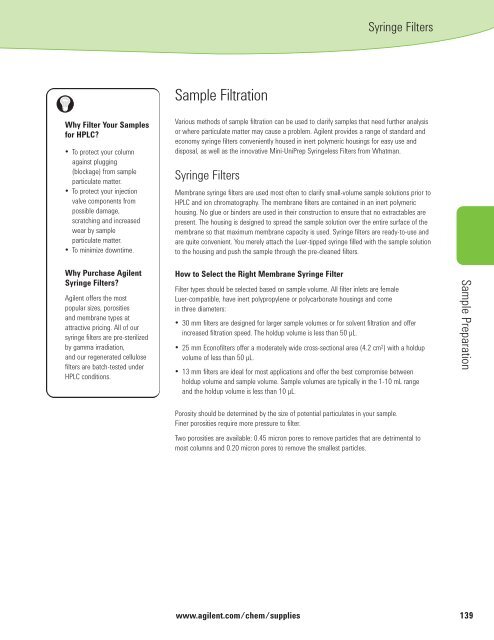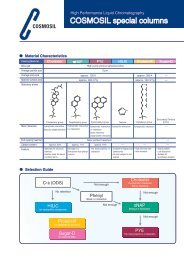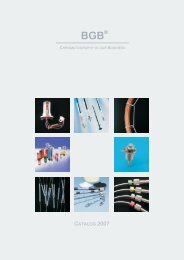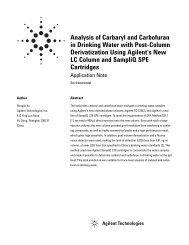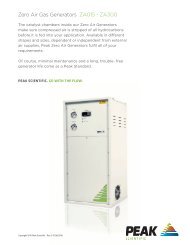- Page 1 and 2:
TABLE OF CONTENTS Featured Products
- Page 3 and 4:
7683B Automatic Liquid Sampler Deli
- Page 5 and 6:
Number of pesticide hits Number of
- Page 7 and 8:
Agilent 1200 Series LC Systems and
- Page 9 and 10:
1200 Series Purification Systems De
- Page 11 and 12:
Agilent 6300 Series Ion Trap LC/MS
- Page 13 and 14:
Make the Change to ICP-MS with Agil
- Page 15 and 16:
BioCel Automation Systems Through i
- Page 17 and 18:
Stratagene Real-time PCR Solutions
- Page 19 and 20:
MS Certified Liners www.agilent.com
- Page 21 and 22:
Focus on what you do best, and leav
- Page 23 and 24:
Agilent Offices Worldwide Australia
- Page 25 and 26:
Brazil Hexis Científica Jundiaí,
- Page 27 and 28:
Japan Yokogawa & Co., Ltd. 7-336, K
- Page 29 and 30:
Thailand Worldco Co. Ltd 63/3 Arun-
- Page 31 and 32:
General Chromatography Supplies Con
- Page 33 and 34:
Agilent Vial Identification Chart a
- Page 35 and 36:
Screw top vials with fixed inserts
- Page 37 and 38:
Preassembled vial pack Pre-Assemble
- Page 39 and 40:
Magnetic crimp caps for CTC, 5188-5
- Page 41 and 42:
Snap caps with septa Snap Top Caps
- Page 43 and 44:
Polypropylene Crimp/Snap Top Vials
- Page 45 and 46:
Micro-V Vials • Wide opening, 1.5
- Page 47 and 48:
8-425 screw top vials 8-425 Screw T
- Page 49 and 50:
4 mL screw top vials 4 mL Screw Top
- Page 51 and 52:
Certified headspace crimp top vials
- Page 53 and 54:
General Purpose Sample and Storage
- Page 55 and 56:
Manual crimper and decapper Micro v
- Page 57 and 58:
Syringes With a broad selection of
- Page 59 and 60:
Straight Needle, 23 and 26s Gauge A
- Page 61 and 62:
10 µl fixed needle 25-500 µL fixe
- Page 63 and 64:
On-column syringe Push pull Push bu
- Page 65 and 66:
CTC Analytics PAL Autosampler Suppl
- Page 67 and 68:
Fixed needle, G6500-80109 CombiPAL
- Page 69 and 70:
X-type fixed needle, G4200-80118 Re
- Page 71 and 72:
Sample tray, G6500-80101 Well plate
- Page 73 and 74:
Carrier Gas Purification Gas supply
- Page 75 and 76:
Gas Purifier Selection Guide In Lin
- Page 77 and 78:
a b (Figures a and b. The “plus
- Page 79 and 80:
Triple filter cartridge, 5182-9705
- Page 81 and 82:
Gas Traps www.agilent.com/chem/supp
- Page 83 and 84:
Molecular Sieve 5A and Indicating D
- Page 85 and 86:
Moisture S-trap Big moisture trap M
- Page 87 and 88: Big oxygen trap Big hydrocarbon tra
- Page 89 and 90: Capillary Grade Hydrocarbon Traps (
- Page 91 and 92: Hydrocarbon Moisture trap Hydrocarb
- Page 93 and 94: Split vent trap and cartridges, RDT
- Page 95 and 96: ADM 1000 ADM 2000 ADM 1000 www.agil
- Page 97 and 98: Low Gas Alarm System, 2.0 and 2.5 i
- Page 99 and 100: www.agilent.com/chem/supplies Regul
- Page 101 and 102: Fittings kit, 5180-4161 GC Installa
- Page 103 and 104: Brass adapter, 0100-0420 Stainless
- Page 105 and 106: Reducing union, 0100-0241 Reducing
- Page 107 and 108: Hex Keys, 5064-8211 Screwdrivers De
- Page 109 and 110: Capillary and Megabore ferrule tool
- Page 111 and 112: FID cleaning kit, 9301-0985 GC Budd
- Page 113 and 114: Ink cartridge, 5181-1220 Integrator
- Page 115 and 116: HPIB and GPIB Cables Integrators, I
- Page 117 and 118: Sample Preparation Improve the qual
- Page 119 and 120: Move more quickly toward the method
- Page 121 and 122: R 1 Sulfonic acid-modified divinyl
- Page 123 and 124: O Si O Si (CH2) 17CH3 Si O Si(CH 3)
- Page 125 and 126: Structure of ethyl (C2) silane, cov
- Page 127 and 128: Si O Si O Si OH Structure of diol s
- Page 129 and 130: Additional Agilent SampliQ SPE Phas
- Page 131 and 132: SampliQ Carbon SampliQ Carbon (grap
- Page 133 and 134: Agilent SampliQ Bulk Sorbents www.a
- Page 135 and 136: 20-Port Vacuum Manifold Assembly, 5
- Page 137: Vacuum Manifolds for 96 Well Plates
- Page 141 and 142: Membrane Econofilters, 5185-5830 Re
- Page 143 and 144: Tips & Tools For more information,
- Page 145 and 146: GC and GC/MS For over 40 years, Agi
- Page 147 and 148: GC and GC/MS Maintenance Schedule w
- Page 149 and 150: BTO septa, 5183-4757 Summary of Pre
- Page 151 and 152: Septa Troubleshooting General Purpo
- Page 153 and 154: MS certified split liner, 5188-6576
- Page 155 and 156: Agilent splitless liners Single tap
- Page 157 and 158: Certified gold inlet seal, 5188-536
- Page 159 and 160: Ferrule Selection Recommendations w
- Page 161 and 162: Universal column nut, 5181-8830 Col
- Page 163 and 164: Glass press-fit connections Quartz
- Page 165 and 166: Capillary Flow Technology Supplies
- Page 167 and 168: A B C Valve Supplies Description Pa
- Page 169 and 170: Markes Thermal Desorption Markes Th
- Page 171 and 172: Bar code reader labels Automatic Li
- Page 173 and 174: G1888A Headspace unit G1888A Networ
- Page 175 and 176: Flip Top Inlet Sealing System insta
- Page 177 and 178: Split/Splitless Inlet assembly Spli
- Page 179 and 180: 1a 5 6 1b 2 3 1c 1d Cool On-Column
- Page 181 and 182: Tips & Tools For new PTV technology
- Page 183 and 184: Flame Ionization Detector (FID) FID
- Page 185 and 186: FID cleaning kit, 9301-0985 Flame I
- Page 187 and 188: Detector fitting Front ferrule Back
- Page 189 and 190:
www.agilent.com/chem/supplies Flame
- Page 191 and 192:
www.agilent.com/chem/supplies Nitro
- Page 193 and 194:
13 14 17 18 1 3 4 5 6 15 16 8 7 Nit
- Page 195 and 196:
Sulfur Chemiluminescence Detector (
- Page 197 and 198:
Cool On-Column Inlets for Manual In
- Page 199 and 200:
7 5890 FID 2 3 4 5 8 9 6 Flame Ioni
- Page 201 and 202:
ECD make up gas adapter ECD packed
- Page 203 and 204:
GC Standards GC Qualitative Standar
- Page 205 and 206:
GC/MS Systems • Less downtime for
- Page 207 and 208:
MS interface column nut, 05988-2006
- Page 209 and 210:
Electron Impact (EI) Ion Source Ion
- Page 211 and 212:
Tips & Tools Visual appearance is n
- Page 213 and 214:
EI high temperature filament, G2590
- Page 215 and 216:
Foreline Pump Vacuum Systems and Pu
- Page 217 and 218:
MS Test and Performance Samples MS
- Page 219 and 220:
Always Quality. Always Innovative.
- Page 221 and 222:
Tips & Tools See where quality begi
- Page 223 and 224:
Agilent's Über One Test Probe Mixt
- Page 225 and 226:
High Efficiency Capillary GC Column
- Page 227 and 228:
Spearmint Oil Carrier: A: Helium 25
- Page 229 and 230:
Structure of Dimethylpolysiloxane D
- Page 231 and 232:
CH 3 CH 3 CH 3 O Si Si O Si CH3 CH3
- Page 233 and 234:
CH 3 O Si CH 3 Structure of Dipheny
- Page 235 and 236:
CH 3 DB-35ms Chromatograms Environm
- Page 237 and 238:
DuraGuard www.agilent.com/chem/supp
- Page 239 and 240:
Structure of Dimethylpolysiloxane D
- Page 241 and 242:
DB-1 www.agilent.com/chem/supplies
- Page 243 and 244:
HP-1 0.32 15 0.25 -60 to 325/350 19
- Page 245 and 246:
DB-5 www.agilent.com/chem/supplies
- Page 247 and 248:
HP-5 www.agilent.com/chem/supplies
- Page 249 and 250:
CH 3 O Si O Si Structure of Dipheny
- Page 251 and 252:
O CH 3 C 6H 5 Si O Si CH 3 50% C 6H
- Page 253 and 254:
O Si Structure of trifluoropropylme
- Page 255 and 256:
DB-1301 • (6%-Cyanopropyl-phenyl)
- Page 257 and 258:
-HO H H C C O H H Structure of Poly
- Page 259 and 260:
DB-WAX and DB-WaxFF www.agilent.com
- Page 261 and 262:
HP-INNOWax Chromatograms Food, Flav
- Page 263 and 264:
HP-FFAP Chromatograms Food, Flavors
- Page 265 and 266:
Chiral Columns Special Application
- Page 267 and 268:
Cyclodex-B Chromatograms Food, Flav
- Page 269 and 270:
DB-5ht Chromatograms Food, Flavors
- Page 271 and 272:
DB-EVDX Chromatograms Life Sciences
- Page 273 and 274:
DB-608 Chromatograms Environmental
- Page 275 and 276:
DB-HT SimDis Chromatograms Petroleu
- Page 277 and 278:
DB-Dioxin Chromatograms Environment
- Page 279 and 280:
DB-VRX Chromatograms Environmental
- Page 281 and 282:
HP-VOC • Selectivity engineered f
- Page 283 and 284:
PLOT Columns www.agilent.com/chem/s
- Page 285 and 286:
GS-Alumina KCl Chromatograms Petrol
- Page 287 and 288:
GS-GasPro Chromatograms Environment
- Page 289 and 290:
HP-PLOT Q Chromatograms Environment
- Page 291 and 292:
Metal Columns DB-ProSteel • Excel
- Page 293 and 294:
CAM Chromatograms Industrial Chemic
- Page 295 and 296:
Custom GC Column Ordering Even thou
- Page 297 and 298:
DB-1, 5 in. cage ID (mm) Length (m)
- Page 299 and 300:
DB-17, 5 in. cage ID (mm) Length (m
- Page 301 and 302:
DB-1701P, 5 in. cage ID (mm) Length
- Page 303 and 304:
GS-Q, 5 in. cage ID (mm) Length (m)
- Page 305 and 306:
HP-20M, 5 in. cage ID (mm) Length (
- Page 307 and 308:
HP-PLOT Molesieve, 5 in. cage www.a
- Page 309 and 310:
Agilent LTM System CAM LTM Column M
- Page 311 and 312:
0.20 12 0.33 -60 to 325/350 128-101
- Page 313 and 314:
DB-1ms LTM Column Modules ID (mm) L
- Page 315 and 316:
DB-17ms LTM Column Modules ID (mm)
- Page 317 and 318:
DB-23 LTM Column Modules ID (mm) Le
- Page 319 and 320:
DB-5 LTM Column Modules ID (mm) Len
- Page 321 and 322:
DB-5.625 LTM Column Modules www.agi
- Page 323 and 324:
DB-WAX LTM Column Modules www.agile
- Page 325 and 326:
GS-Q LTM Column Modules ID (mm) Len
- Page 327 and 328:
HP-5 LTM Column Modules www.agilent
- Page 329 and 330:
HP-PLOT Al2O3 "M" LTM Column Module
- Page 331 and 332:
HP-PLOT Q LTM Column Modules www.ag
- Page 333 and 334:
Fused Silica Tubing Deactivated Tub
- Page 335 and 336:
GC Column Application and Method Gu
- Page 337 and 338:
GC Columns Stationary Phase Applica
- Page 339 and 340:
GC Columns Stationary Phase Applica
- Page 341 and 342:
Environmental/EPA Methods Analyte T
- Page 343 and 344:
Environmental/EPA Methods EPA Metho
- Page 345 and 346:
ASTM Methods Method Designation Met
- Page 347 and 348:
ASTM Methods Method Designation Met
- Page 349 and 350:
ASTM Methods Method Designation Met
- Page 351 and 352:
Baseline Instability or Disturbance
- Page 353 and 354:
Loss of Resolution GC Column Troubl
- Page 355 and 356:
www.agilent.com/chem/supplies Solve
- Page 357 and 358:
Alphabetical Order By Analyte (Cont
- Page 359 and 360:
Environmental Applications, Hydroca
- Page 361 and 362:
Environmental Applications, Pestici
- Page 363 and 364:
Organochlorine Pesticides I EPA Met
- Page 365 and 366:
Chlorinated Pesticides, EPA Method
- Page 367 and 368:
Organochlorine Pesticides III Colum
- Page 369 and 370:
Nitrogen/Phosphorus Containing Pest
- Page 371 and 372:
Herbicides II Column: DB-210 122-02
- Page 373 and 374:
Environmental Applications, Semivol
- Page 375 and 376:
Semivolatile Compounds, EPA Method
- Page 377 and 378:
PBDEs by ECD Column: DB-XLB 15 m x
- Page 379 and 380:
PCBs by EPA Method 8082 Column: DB-
- Page 381 and 382:
Organotin Compounds II Column: HP-5
- Page 383 and 384:
EPA Method 8061 (Phthalate Esters)
- Page 385 and 386:
Phenols Column: DB-5ms 122-5532 30
- Page 387 and 388:
Environmental Applications, Volatil
- Page 389 and 390:
Extended Analyte List for EPA Metho
- Page 391 and 392:
EPA Method 551 Column: DB-1 122-103
- Page 393 and 394:
EPA Air Analysis Method TO-15 (1 pp
- Page 395 and 396:
C1 and C2 Halocarbons (Freons) Colu
- Page 397 and 398:
Foods, Flavors and Fragrance Applic
- Page 399 and 400:
Fragrance Reference Standard II Col
- Page 401 and 402:
Flavor Mixture Column: ULTRA 2 1909
- Page 403 and 404:
Peppermint Oil Column: DB-WAX 122-7
- Page 405 and 406:
Rosemary Oil Column: Cyclosil-b 112
- Page 407 and 408:
Strawberry Syrup Column: HP-INNOWax
- Page 409 and 410:
Organic Acids Column: DB-FFAP 122-3
- Page 411 and 412:
Polyunsaturated Fatty Acid Methyl E
- Page 413 and 414:
FAME Standard II Column: DB-225 127
- Page 415 and 416:
Butter Triglycerides I Column: DB-5
- Page 417 and 418:
Alcohols II Column: DB-WAXetr 123-7
- Page 419 and 420:
Free Organic Acids/C4-C5 Isomers Co
- Page 421 and 422:
Amines and Nitriles Column: DB-5ms
- Page 423 and 424:
Aldehydes and Ketones Column: DB-1
- Page 425 and 426:
PFBHA Derivative Column: DB-1 123-1
- Page 427 and 428:
Impurities in Styrene Column: DB-WA
- Page 429 and 430:
Esters I Column: DB-1 125-1034 30 m
- Page 431 and 432:
Glycols I Column: DB-WAX 124-7032 3
- Page 433 and 434:
Ethylene Glycol Mixture Column: ULT
- Page 435 and 436:
Halogenated Hydrocarbons II Column:
- Page 437 and 438:
Solvents II Column: DB-WAXetr 123-7
- Page 439 and 440:
Common Industrial Solvents Column:
- Page 441 and 442:
Acrylate Impurities II Column: DB-1
- Page 443 and 444:
Phenols I Column: HP-5ms 19091S-433
- Page 445 and 446:
Ethylene Oxide Column: DB-WAX 122-7
- Page 447 and 448:
Life Science Applications Benzodiaz
- Page 449 and 450:
Drug Screen Column: DB-1ms 122-0132
- Page 451 and 452:
Anticonvulsants Column: DB-1 125-10
- Page 453 and 454:
Barbiturates Column: DB-35ms 122-38
- Page 455 and 456:
Hallucinogens Column: DB-17ms 122-4
- Page 457 and 458:
Over-the-Counter Pain Killers - TMS
- Page 459 and 460:
Blood Alcohols I (Static Headspace/
- Page 461 and 462:
Blood Pollutants II Column: DB-ALC1
- Page 463 and 464:
Residual Solvents Column: DB-624 12
- Page 465 and 466:
Selected Oxygenates Column: GS-OxyP
- Page 467 and 468:
Natural Gas Column: HP-PLOT Al2O3 S
- Page 469 and 470:
Propylene Column: GS-Alumina 115-35
- Page 471 and 472:
Extended Hydrocarbon Analysis I Col
- Page 473 and 474:
Refinery Gas I Column: HP-PLOT Q 19
- Page 475 and 476:
Sulfur Gas Analysis in Light Hydroc
- Page 477 and 478:
Sulfur Compounds in Propylene (1 pp
- Page 479 and 480:
Aromatics Analysis - Ethylbenzene I
- Page 481 and 482:
Denatured Fuel Ethanol-ASTM D5501 C
- Page 483 and 484:
Simulated Distillation Column: DB-2
- Page 485 and 486:
n-Paraffin Standard Column: DB-HT S
- Page 487 and 488:
LC and LC/MS Run samples up to 20x
- Page 489 and 490:
Universal Connection Capillaries
- Page 491 and 492:
Plastic tubing cutter, 8710-1930 PE
- Page 493 and 494:
Stainless steel fittings, 5062-2418
- Page 495 and 496:
Semi prep filter, 5064-8273 High pr
- Page 497 and 498:
Glass solvent filter degasser, 3150
- Page 499 and 500:
www.agilent.com/chem/supplies Manua
- Page 501 and 502:
Stainless steel sample loops www.ag
- Page 503 and 504:
Syringes for manual injection valve
- Page 505 and 506:
1100/1200 Series LC Maintenance Sch
- Page 507 and 508:
Mounting tool, 0100-1710 Capillary
- Page 509 and 510:
Pumps www.agilent.com/chem/supplies
- Page 511 and 512:
Outlet ball valve, G1311-60012 Acti
- Page 513 and 514:
Pump start up kit, G1311-68710 Solv
- Page 515 and 516:
Prep filter, 5065-4500 Prep bottle,
- Page 517 and 518:
1100/1200 Series LC System Needles
- Page 519 and 520:
Sample loop, 01078-87302 www.agilen
- Page 521 and 522:
G1367A well plate autosampler G1387
- Page 523 and 524:
G2255-68700 Vial plate, 5022-6539 W
- Page 525 and 526:
G2260A 1100/1200 Series Preparative
- Page 527 and 528:
1100/1200 Series Fraction Collector
- Page 529 and 530:
1200 Series LC Solution Kits Biocom
- Page 531 and 532:
1100/1200 Series LC System Connecti
- Page 533 and 534:
1200 Rapid Resolution Connection Ca
- Page 535 and 536:
Standard flow cell Standard flow ce
- Page 537 and 538:
Micro flow cell High pressure flow
- Page 539 and 540:
8 Deuterium longlife lamp, 2140-081
- Page 541 and 542:
Diode Array Detector (DAD)/Multiple
- Page 543 and 544:
Diode Array Detector (DAD)/Multiple
- Page 545 and 546:
Stainless steel front ferrules, 518
- Page 547 and 548:
Piston seals, 5063-6589 PTFE frits,
- Page 549 and 550:
Deuterium lamp, G1314-60100 Variabl
- Page 551 and 552:
6100 Series Single Quadropole LC/MS
- Page 553 and 554:
6200 Series TOF LC/MS Supplies www.
- Page 555 and 556:
6300 Series Ion Trap LC/MS Supplies
- Page 557 and 558:
6400 Series Triple Quadropole LC/MS
- Page 559 and 560:
6500 Series Accurate-Mass Q-TOF LC/
- Page 561 and 562:
Quiet Cover Quiet Cover Agilent has
- Page 563 and 564:
Column and Mobile Phase Guidelines:
- Page 565 and 566:
pH and Mobile Phase The choice of m
- Page 567 and 568:
Analyte charge Silica surface charg
- Page 569 and 570:
Method development at mid pH (4-9)
- Page 571 and 572:
USP Designations The US Pharmacopei
- Page 573 and 574:
USP Designations USP Packing Materi
- Page 575 and 576:
USP Designations USP Packing Materi
- Page 577 and 578:
Cartridge/Guard Cartridge Systems C
- Page 579 and 580:
This icon identifies stand-alone gu
- Page 581 and 582:
This icon identifies preparative gu
- Page 583 and 584:
HPLC Column Protection Column Prote
- Page 585 and 586:
ZORBAX Rx-SIL uniform sub particles
- Page 587 and 588:
ZORBAX Reversed-Phase Columns The f
- Page 589 and 590:
Poroshell 120 • High efficiency a
- Page 591 and 592:
ZORBAX Eclipse Plus: Best Peak Shap
- Page 593 and 594:
ZORBAX Eclipse Plus Hardware Descri
- Page 595 and 596:
ZORBAX Eclipse PAH Hardware Descrip
- Page 597 and 598:
Good Peak Shape Over a Wide pH Rang
- Page 599 and 600:
Selectivity Changes for Basic Compo
- Page 601 and 602:
ZORBAX Eclipse XDB Hardware Descrip
- Page 603 and 604:
ZORBAX Eclipse XDB Hardware Descrip
- Page 605 and 606:
StableBond SB-C18 Shows Excellent S
- Page 607 and 608:
Five Different Bonded Phases Provid
- Page 609 and 610:
ZORBAX 80Å StableBond Hardware Des
- Page 611 and 612:
ZORBAX 80Å StableBond www.agilent.
- Page 613 and 614:
Improved Peak Shape of Basic Compou
- Page 615 and 616:
ZORBAX Bonus-RP Provides Unique Sel
- Page 617 and 618:
O O Si Si Silica Support C18 C18 No
- Page 619 and 620:
Extend-C18 Provides Good Peak Shape
- Page 621 and 622:
ZORBAX 80Å Extend-C18 Hardware Des
- Page 623 and 624:
ZORBAX Rx Hardware Description Size
- Page 625 and 626:
LiChrospher Reversed-Phase Cartridg
- Page 627 and 628:
Asahipak Reversed-Phase Columns Asa
- Page 629 and 630:
ZORBAX Normal Phase Columns For nor
- Page 631 and 632:
Normal Phase Columns Based on ZORBA
- Page 633 and 634:
LiChrospher Normal-Phase Cartridge
- Page 635 and 636:
Cough-Cold Remedies - ZORBAX 300SCX
- Page 637 and 638:
Poroshell 120 • High efficiency a
- Page 639 and 640:
ZORBAX Rapid Resolution High Throug
- Page 641 and 642:
Rapid Resolution HT Provides Double
- Page 643 and 644:
Long Lifetime of RRHT Columns at El
- Page 645 and 646:
ZORBAX Rapid Resolution High Throug
- Page 647 and 648:
Rapid Resolution Columns Reduce Ana
- Page 649 and 650:
ZORBAX Rapid Resolution 3.5 µm Ecl
- Page 651 and 652:
ZORBAX Solvent Saver • Provide 60
- Page 653 and 654:
ZORBAX Eclipse Plus Description Siz
- Page 655 and 656:
Separation of a Tryptic Digest on Z
- Page 657 and 658:
ZORBAX PrepHT • Easy scale-up fro
- Page 659 and 660:
ZORBAX PrepHT columns are designed
- Page 661 and 662:
ZORBAX PrepHT Eclipse XDB (require
- Page 663 and 664:
Agilent Prep LC Columns • High lo
- Page 665 and 666:
Agilent Prep LC Columns www.agilent
- Page 667 and 668:
Separation of Ethiazide (diuretic d
- Page 669 and 670:
GPC-SEC start-up kit GPC-SEC Start-
- Page 671 and 672:
Organic Standard Chromatograms Aque
- Page 673 and 674:
PLgel Columns Agilent Technologies
- Page 675 and 676:
Polystyrene: Calibration Curves for
- Page 677 and 678:
Separation of Simple-Sugar and Suga
- Page 679 and 680:
High Resolution of 24 Amino Acids U
- Page 681 and 682:
ZORBAX Method Development Kits ZORB
- Page 683 and 684:
ZORBAX Method Validation Kits ZORBA
- Page 685 and 686:
Porous Shell SOLID CORE 5 µm Poros
- Page 687 and 688:
MicroBore Poroshell 300 Columns Pro
- Page 689 and 690:
Short-Chain ZORBAX 300SB-C3 is Stab
- Page 691 and 692:
ZORBAX 300Å StableBond Hardware De
- Page 693 and 694:
Novel Bidentate C18-C18 Bonding for
- Page 695 and 696:
LC/MS Analysis of Angiotensin on Ex
- Page 697 and 698:
ZORBAX GF-250 and GF-450 Gel Filtra
- Page 699 and 700:
ZORBAX GF-250 Shows Extended Column
- Page 701 and 702:
ZORBAX Bio-SCX Series II Provides M
- Page 703 and 704:
High Sensitivity with Capillary Col
- Page 705 and 706:
Proteins in a Complex Sample by 2-D
- Page 707 and 708:
Multiple Affinity Removal System -
- Page 709 and 710:
Column Specifications Multiple Affi
- Page 711 and 712:
Multiple Affinity Removal System -
- Page 713 and 714:
Tips & Tools The Spin Cartridge Rea
- Page 715 and 716:
Luer-Lok syringe, 5188-5250 Luer-Lo
- Page 717 and 718:
Protein In-gel Tryptic Digestion Ki
- Page 719 and 720:
Peptide Cleanup Pipette Tips Peptid
- Page 721 and 722:
HPLC Troubleshooting Symptom Type P
- Page 723 and 724:
LC/MS Troubleshooting Symptom Type
- Page 725 and 726:
Analgesics: High-Speed PrepHT Isocr
- Page 727 and 728:
Cough Formula Mixture: Fast and Eff
- Page 729 and 730:
Use ZORBAX Extend-C18 for Alternate
- Page 731 and 732:
Peptides: Effect of TFA Concentrati
- Page 733 and 734:
Peptide Map - Electronic Flow Contr
- Page 735 and 736:
Peptide RP-HPLC/ESI-MS Using NH4OH
- Page 737 and 738:
Catecholamines/Biogenic Amines: Rap
- Page 739 and 740:
Proteins: Effect of Bonded Phase Co
- Page 741 and 742:
BSA Tryptic Digest on RRHT Column:
- Page 743 and 744:
Polymethacrylate: GPC Separation Co
- Page 745 and 746:
Triton X-114: Decreasing Run-time b
- Page 747 and 748:
Organic Acids Separated on ZORBAX S
- Page 749 and 750:
Anilines, Separation of Substituted
- Page 751 and 752:
Explosives from Soil Extract Column
- Page 753 and 754:
Herbicides: Use of Short, Small Par
- Page 755 and 756:
Triazine Pesticides on Bonus-RP and
- Page 757 and 758:
Plant Hormones: Rapid Gradient Elut
- Page 759 and 760:
Aromatic Flavorings Column: Eclipse
- Page 761 and 762:
Carbohydrates in Colas Column: ZORB
- Page 763 and 764:
Flavoring Agents Column: ZORBAX SB-
- Page 765 and 766:
Parabens: High Speed Separation Col
- Page 767 and 768:
Water-Soluble Vitamins Column: ZORB
- Page 769 and 770:
Fast Vitamin E Analysis on Rapid Re
- Page 771 and 772:
Xanthines: Higher Resolution, Same
- Page 773 and 774:
Anesthetics, Local: Bonded Phase Se
- Page 775 and 776:
Antihistamines Column: ZORBAX Rx-C8
- Page 777 and 778:
Chiral Separation of Fluoxetine Ena
- Page 779 and 780:
Chiral Separation of Tolperison Ena
- Page 781 and 782:
Metronidazole: Updating USP Methods
- Page 783 and 784:
Opiate Drugs, Basic Compounds Showi
- Page 785 and 786:
Steroids Column A: Eclipse XDB-Phen
- Page 787 and 788:
Tricyclic Antidepressants, Screenin
- Page 789 and 790:
Dexamethasone, USP Method: Rapid An
- Page 791 and 792:
Sulfonamides - Fast Analysis with R
- Page 793 and 794:
CE and CE/MS Achieve the sensitivit
- Page 795 and 796:
Tips & Tools Agilent offers a varie
- Page 797 and 798:
µPAGE Basic Kits Includes 3 µPAGE
- Page 799 and 800:
Extended Light Path (Bubble Cell) B
- Page 801 and 802:
www.agilent.com/chem/supplies CE an
- Page 803 and 804:
www.agilent.com/chem/supplies CE an
- Page 805 and 806:
Alignment Interfaces Capillary cass
- Page 807 and 808:
CE/MS Accessories www.agilent.com/c
- Page 809 and 810:
CE Standards & Reagents Premade buf
- Page 811 and 812:
CE System Start-up and Test Kits Ch
- Page 813 and 814:
Accessories www.agilent.com/chem/su
- Page 815 and 816:
ICP-MS The power you need for ultra
- Page 817 and 818:
Gas Line Supplies www.agilent.com/c
- Page 819 and 820:
Peristaltic Pump Tubing and Supplie
- Page 821 and 822:
Concentric Nebulizer, quartz Use wi
- Page 823 and 824:
Quartz spray chamber, G1820-65337 S
- Page 825 and 826:
Interface Cone Guide for Agilent IC
- Page 827 and 828:
Electron multiplier, 5184-1983 Ion
- Page 829 and 830:
Integrated Autosampler Supplies Des
- Page 831 and 832:
ISIS Supplies www.agilent.com/chem/
- Page 833 and 834:
Miscellaneous Supplies Description
- Page 835 and 836:
Single Element Standards Descriptio
- Page 837 and 838:
UV-Vis Keeping your system operatin
- Page 839 and 840:
Semi-Micro Cell with PTFE Lid Semi-
- Page 841 and 842:
Round Aperture Flow Cell Rectangula
- Page 843 and 844:
Deuterium lamp assembly, 2140-0605
- Page 845 and 846:
UV-Vis Standards & Reagents Our che
- Page 847 and 848:
0905-1175..........................
- Page 849 and 850:
123-0131LTM........................
- Page 851 and 852:
125-5032E..........................
- Page 853 and 854:
19091N-133.........................
- Page 855 and 856:
200-0185...........................
- Page 857 and 858:
5064-8286..........................
- Page 859 and 860:
5183-4428..........................
- Page 861 and 862:
5982-4411..........................
- Page 863 and 864:
840300-908.........................
- Page 865 and 866:
959746-906.........................
- Page 867 and 868:
G1530-61580........................
- Page 869 and 870:
G3270-80026........................
- Page 871 and 872:
1,4-Butanediol ....................
- Page 873 and 874:
Dicrotophos .......................
- Page 875 and 876:
1,2,3,4,6,7,8-Hepta chloro dibenzof
- Page 877 and 878:
Octadecane ........................
- Page 879 and 880:
Triethylenetetramine (4 isomers) ..
- Page 881 and 882:
Caps 8-425 Screw Top No Septa......
- Page 883 and 884:
GC Installation Kits Basic Installa
- Page 885 and 886:
Moisture Traps Cont. Silica Gel, Gr
- Page 887 and 888:
Vials Cont. 2 mL Glass ............
- Page 889 and 890:
Easy Ways To Order* • For Interna
- Page 891 and 892:
Agilent Technologies Order Form Agi
- Page 893 and 894:
Agilent Technologies Order Form Agi
- Page 895 and 896:
Agilent Technologies Order Form Agi


